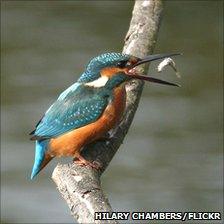Why are kingfishers making a comeback?
- Published

A female with freshly caught fish - her bright lower beak is called "lipstick"
A new wildlife survey shows sightings of these iridescent water birds have trebled in the UK. Why?
Quick. Look. That darting speck of blue-green and rust-red - a kingfisher dipping into a river to catch a minnow. A fleeting flash of colour is all many people will see of a fast-flying kingfisher.
In an annual survey of wildlife spotted around rivers and canals for British Waterways, the number of kingfishers seen by members of the public between March and September has risen 217% to 596, despite fears many of the birds might not survive last winter's icy spell.
British Waterways says this shows the UK's freshwater courses - slow-flowing streams, canals and lakes are the kingfisher's natural habitat - are cleaner and better able to support a thriving ecosystem.
Water quality is a key factor in the kingfisher's survival. It feeds on tadpoles, aquatic insects and small fish such as minnows and sticklebacks - so the water needs to be clean enough for the bird to see its tiny prey as it skims across the surface, or peers from an overhanging branch. Once it dives into the water, a kingfisher is effectively hunting blind, its eyes protected by a third eyelid.
A kingfisher needs to eat its body weight in fish and insects each day. And with chicks to feed, a breeding pair must hunt during every moment of daylight - in a family with seven chicks, the adults must catch about 5,000 fish throughout the summer.
The RSPB estimates there are between 4,800 and 8,000 breeding pairs thinly, but widely, spread across the UK. Their scarcity mean kingfishers are protected under Schedule 1 of the Wildlife and Countryside Act 1981, external. It is illegal to take, kill or injure a kingfisher or its nest, eggs or young, or to intentionally disturb the birds during breeding season.
The kingfisher is not the only British waterbird to suffer from centuries of polluted waterways and wetlands drained for agriculture. Herons, cranes and avocets have also declined.
But the tide is now turning. Efforts are underway to clean up waterways and preserve, or make anew, places for these birds to live. This is in part thanks to special grants being made available, and farmers returning land to its former use.
The RSPB is surprised but heartened by the reported bounce in kingfisher sightings. Conservation spokesman Grahame Madge had feared a population drop of up to a third after last winter, the coldest in 30 years.
"In the hard winter of 1963, there was 85% mortality in some areas, and local extinction in others. Kingfishers are one of the worst affected by cold winters because they feed in shallow waters that ice over, leaving them at risk of starvation."
But they are also well placed to recover after such a catastrophe - they reproduce fast and a breeding pair can raise three broods of chicks in a single season.
"They have also adapted very well to the habitat we provide for them, with the canal network and old gravel pits made over into wetland recreation areas," says Mr Madge. "They even can be seen in the centre of cities such as Manchester, Birmingham and Exeter."

A male, as its beak is black
Not only have polluted waters and icy weather done for kingfishers in the past, the little birds have been a victim of their own striking beauty.
Far more colourful than the average British bird, their electric blue plumage was sought after in Victorian times. "Their feathers were used in the production of fishing flies, and egg collecting was a popular pastime," says Mr Madge.
This was also an era when feathers, wings, even whole birds adorned the hats, stoles and dresses of society women, and taxidermists preserved stuffed birds under glass for those keen to bring a little piece of the countryside into their homes.
Not all well-to-do ladies of the time were so keen on these trends. A group in Manchester so objected to this needless slaughter, they took a stand against the plumage trade.
"They went to church and noted down the names the ladies wearing these hats, and the next day these ladies would receive a hectoring letter pointing out the suffering of the bird that adorned their hat," says environmental historian Dr Rob Lambert, of Nottingham University, in BBC Four's Birds Britannia.
By 1889, they had enough supporters to form their own society, which 15 years later became the Royal Society for the Protection of Birds.
While the British are no less keen on birds today, today's collectors gather sightings and photographs, rather than plumage and stuffed specimens.
Compiled by Megan Lane